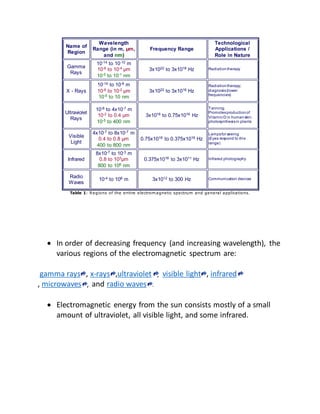Recommended
SHAPE SocietyDiffuse reflectance nir of plaque intracoronary device

Diffuse reflectance nir of plaque intracoronary deviceSociety for Heart Attack Prevention and Eradication
Recommended
SHAPE SocietyDiffuse reflectance nir of plaque intracoronary device

Diffuse reflectance nir of plaque intracoronary deviceSociety for Heart Attack Prevention and Eradication
More Related Content
What's hot
What's hot (20)
electrical_project_chandresh_report on laser Transmitter and Receiver_ final ...

electrical_project_chandresh_report on laser Transmitter and Receiver_ final ...
Rad 206 p12 Fundamentals of Imaging - Control of Scatter Radiation

Rad 206 p12 Fundamentals of Imaging - Control of Scatter Radiation
Extreme Bandwidth Wireless Area Networks Utilizing Terahertz Frequencies

Extreme Bandwidth Wireless Area Networks Utilizing Terahertz Frequencies
Similar to Name of region
Similar to Name of region (20)
Electromagnetic Spectrum PowerPoint Presentation for Teachers/Students

Electromagnetic Spectrum PowerPoint Presentation for Teachers/Students
Name of region
- 1. Name of Region Wavelength Range (in m, μm, and nm) Frequency Range Technological Applications / Role in Nature Gamma Rays 10-14 to 10-10 m 10-8 to 10-4 μm 10-5 to 10-1 nm 3x1022 to 3x1018 Hz Radiation therapy X - Rays 10-14 to 10-8 m 10-8 to 10-2 μm 10-5 to 10 nm 3x1022 to 3x1016 Hz Radiation therapy; diagnosis (lower frequencies) Ultraviolet Rays 10-8 to 4x10-7 m 10-2 to 0.4 μm 10-5 to 400 nm 3x1016 to 0.75x1016 Hz Tanning; Promotes production of Vitamin D in human skin; photosynthesis in plants Visible Light 4x10-7 to 8x10-7 m 0.4 to 0.8 μm 400 to 800 nm 0.75x1016 to 0.375x1016 Hz Lamps for seeing (Eyes respond to this range) Infrared 8x10-7 to 10-3 m 0.8 to 103μm 800 to 106 nm 0.375x1016 to 3x1011 Hz Infrared photography Radio Waves 10-4 to 106 m 3x1012 to 300 Hz Communication devices Table 1: Regions of the entire electromagnetic spectrum and general applications. In order of decreasing frequency (and increasing wavelength), the various regions of the electromagnetic spectrum are: gamma rays , x-rays ,ultraviolet , visible light , infrared , microwaves , and radio waves . Electromagnetic energy from the sun consists mostly of a small amount of ultraviolet, all visible light, and some infrared.
- 2. Light is a particular type of electromagnetic radiation that can be seen and sensed by the human eye, but this energy exists at a wide range of wavelengths. The micron is the basic unit for measuring the wavelength of electromagnetic waves. The spectrum of waves is divided into sections based on wavelength. The shortest waves are gamma rays, which have wavelengths of 10e-6 microns or less. The longest waves are radio waves, which have wavelengths of many kilometers. The range of visible consists of the narrow portion of the spectrum, from 0.4 microns (blue) to 0.7 microns (red).
